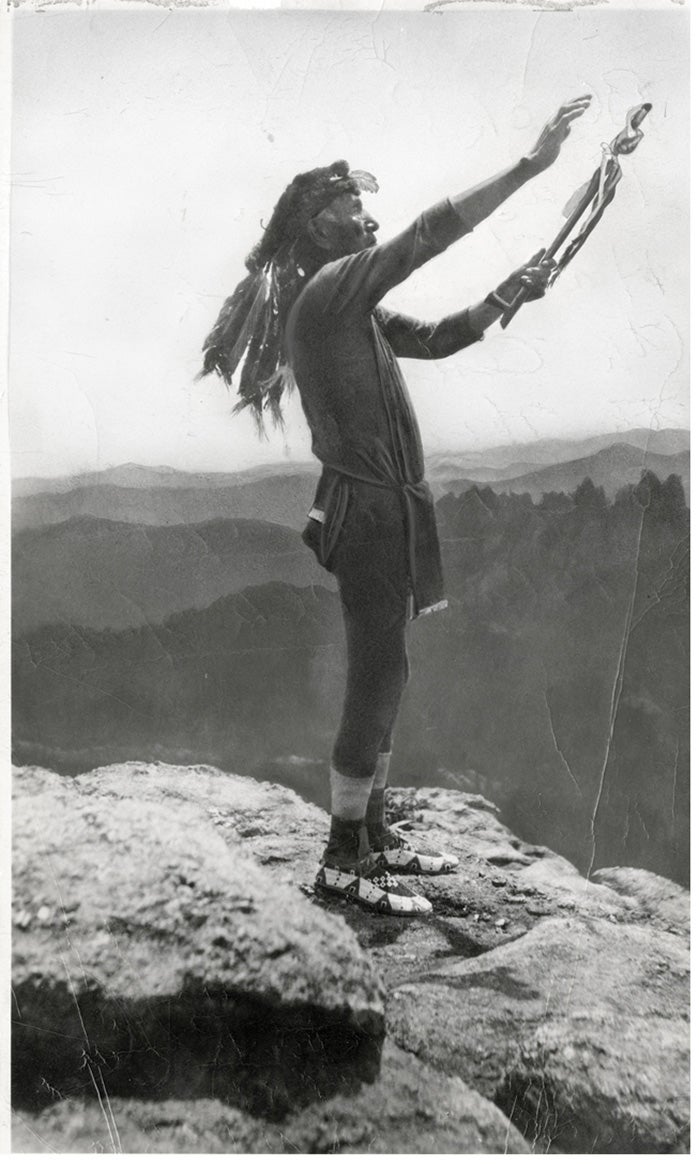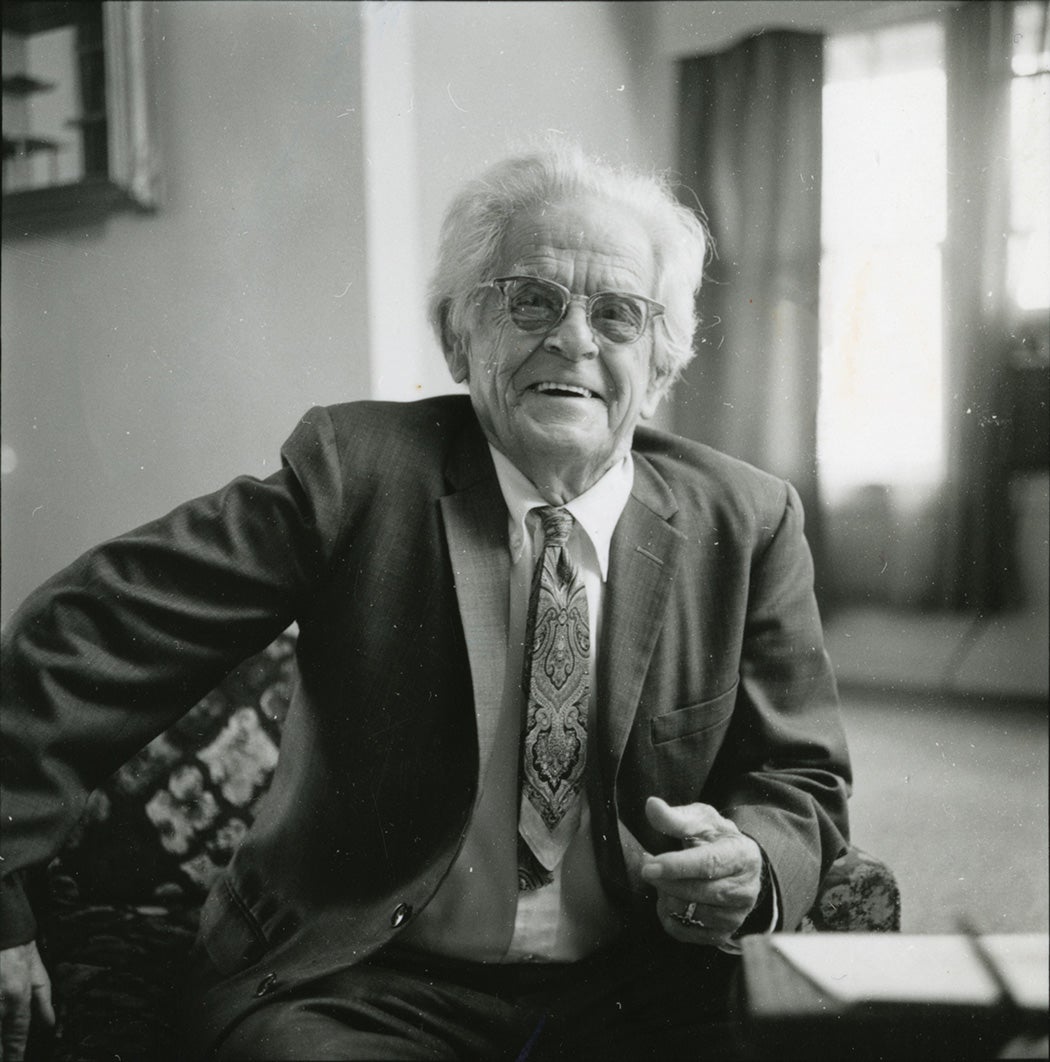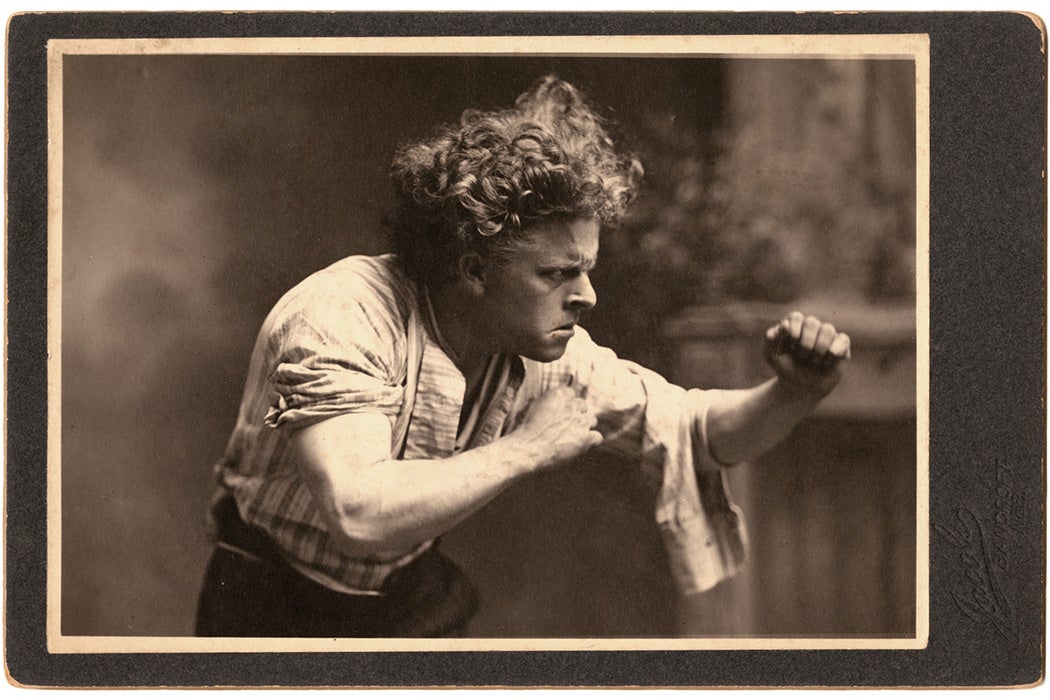In August 1930, a forty-nine-year-old American poet was gathering material for the final part of the grand epic he had been writing for the past twenty years. Its subject was the bloody story of westward expansion from the 1820s to the 1890s: from the perilous exploits of European explorers to the endurance of the Lakota and other Native peoples of the Great Plains, defending themselves from annihilation. The poet, John Gneisenau Neihardt, wanted first-hand accounts of the dying days of the “Indian Wars” that symbolically concluded with the massacre of nearly 300 Lakota people at Wounded Knee, on December 29, 1890. Passing through the Lakota Pine Ridge Reservation in South Dakota, Neihardt was told to take a dirt road up to a small wooden cabin to visit Black Elk, a wičháša wakȟáŋ, or holy medicine man. He was nearing seventy and had been a witness to his people, participating in the victories of Crazy Horse (a second cousin) and escaping the events at Wounded Knee. As he approached the cabin, Neihardt later wrote, the old man was standing outside, as if expecting him.
Published in 1932, Black Elk Speaks was the astonishing result of a strange meeting of minds, cultures, and civilizations. The book is both a spiritual autobiography and an intensely grounded and historical one, both individual and collective, of Black Elk’s life from boyhood to maturity (it ends when he is twenty-seven, at Wounded Knee) and—allegedly—a uniquely authentic account of Lakota history, spiritual, and society. The truth, time has showed, is more complicated. As the book gained popularity among both Native and white readers, it attracted increased scrutiny. Today, controversy over its authenticity persists, yet it remains by far the most popular and arguably influential book “written” by a Native author in America. And in most places outside of Nebraska—where Neihardt was the state’s “poet laureate in perpetuity” from 1921 till his death in 1973—it is also the sole book by which Neihardt is known.
This is ironic, of course. Neihardt was initially indicated to be acting as interpreter and scribe in this major work of “Indian autobiography:” the original edition of Black Elk Speaks described the story as “told to John G. Neihardt.” In later editions, however, Neihardt amended that front page to “written through John G. Neihardt”—with good reason, and with more honesty. The book is a collaboration, in ways both powerful and troubling.

There was no apparent reason for Black Elk to trust Neihardt, a white poet, with any knowledge of his personal history, nor that of his people or their culture. Yet, in May, 1931, about nine months after that initial meeting, Neihardt and two daughters returned to where Black Elk had set up a sacred tepee for them to stay in. Over roughly the next fortnight, Black Elk (and other Lakota elders, including his friend Standing Bear) would speak through his son, Ben, who translated the Lakota words into English for Neihardt; stenographic notes were taken by Neihardt’s daughter Enid.
Weekly Newsletter
As Neihardt repeated in the various prefaces he wrote to the book over the years, there was an immediate understanding between the two men, and Black Elk was compelled to share things he had never discussed with anyone.
“You have been sent so that I may teach you and you receive what I know,” Black Elk reportedly said. “It was given to me for men, and it is true, and it is beautiful, and soon I will be under the grass.”
In fact, Black Elk would live to the age of eighty-seven, dying in 1950, but in the 1930s, with the Lakota embroiled in constant hardship, he clearly felt the need to unburden himself.
“He knew that I was the tool—no, the medium,” Neihardt later related to writer Sally McCluskey, “for what he wanted to get said.”
The book’s centerpiece is a “Great Vision,” which Black Elk experienced when he was nine years old. Black Elk came from a family of holy men, and his vision fell in a tradition common to many Native belief systems, in which a vision is presented to one individual who must share it in a way that helps the community. With language and imagery that recalls the Book of Revelation, Black Elk describes a sky “filled with glowing clouds of manes and tails of horses in all colors singing back,” ending with an apotheosis of goodness and peace:
I understood more than I saw; for I saw … the shapes of all things in the spirit, and the shape of all shapes as they must live together like one being. And I saw that the sacred hoop of my people was one of many hoops that made one circle.
In its totality, the Vision is a treasure in American literature.
There’s no doubting the power, directness, and beauty of Black Elk Speaks as a whole. But it’s more than that: Black Elk saw his Great Vision as “for men,” probably all of them, but also very specifically, for his people. Beyond being purely an account of and for the Lakota, the book was taken up as a kind of pan-nation Native guide for reviving pre-colonial traditions at the same time as it experienced pushback. Beginning in the 1960s, amid the rise of the counterculture and alternative “spiritual paths,” young (white) people were becoming interested in these same traditions, yet often misapprehending them. It matters how we read Black Elk Speaks because for years it has informed white peoples’ understanding of who Native people are, with all the potential harm that entails. And so it matters that we should know too about its oft-neglected co-author.
Born in 1881, in a one-room cabin in Sharpsburg, Illinois, Neihardt was a precocious child, and, like Black Elk, his future was swayed by a mystical vision he had as a boy. In his case, it pointed him on path to poetry.
“All my work has been notable for its mysticism,” he said in 1973, “although I’ve been a very great realist too. I believe in realism, but I think realism covers a wider scope than most people think. I was always aware of what I call the Otherness of things, the other side of things.”
This mysticism was embodied in a love for the grand natural surroundings of his boyhood, like the Missouri River, and it was this sensibility, combined with his obsession with understanding the still-recent history of the American West, that eventually went into the dream of a grand epic that had captured Neihardt’s imagination since his youth.
As a boy, he moved with his family from Illinois to Kansas to Nebraska, where he graduated at sixteen from Wayne State College. Neihardt taught and worked various jobs before gaining steady employment as a critic and, increasingly, lecturing on and reading his poetry. At nineteen, he published his first book, The Divine Enchantment, a record of his fascination with Hindu philosophies. An autodidact, Neihardt was a wide-ranging reader and thinker, writing more than three thousand essays and reviews for popular publications on subjects ranging from ecology and physics to mysticism and paranormal phenomena.
In 1912, at the age of thirty-one, Neihardt considered himself ready to embark on A Cycle of the West, his life’s work. He would be writing it for twenty-nine years, not publishing the final volume until 1941. (Imitating Virgil as he wrote his Aeneid, he would typically write three lines a day.) In the five individual narratives, styled as “Songs,” Neihardt tells a different story of the vast settlement and bloodshed over the West, from the perspectives of both whites and Natives. For each he undertook exhaustive research, gathering material both from the archives and on the ground, traversing the land while speaking to those who had been part of that tumultuous century of “manifest destiny”—still, in 1930, within living memory.

Both as mystic and historian, Neihardt was searching for eternal values, for placing the struggles of the present and himself within a “whole scale” that reached backward and made a unity of history. He had read and studied Homer and the whole epic tradition that preserved what he called “the heroic spirit:” Aeneas, Sigurd, King Arthur, Roland, Abraham, David. To Neihardt, the story of the conquest of the West was in the same tradition, as grand in its scope; as literary history Paul Olson writes, Neihardt wished
to show the present and recent past as capable of heroism. The climate of a frontier … where boundaries between cultures are uncertain and even those between culture and nature sometimes ambiguous—lent itself to heroic storytelling.
For a poet writing in the first half of the twentieth century, of course, this kind of ambition was regressive—retrograde even—and Neihardt’s lifelong avoidance of urbane literary circles added to their neglect of his work. Ezra Pound, Modernist literature’s master-builder, began publishing his own epic of historical and mythic fragments, The Cantos, in the same decade that Neihardt published “Song of Three Friends“ and “Song of Hugh Glass,” the Cycle’s first two parts. In its refusal or inability to “cohere” the maelstrom of twentieth-century existence into the old structure of the past, the work of Pound, his mentee T.S. Eliot, and the whole tradition of modern poetry was utterly opposed to Neihardt’s vision.
To make matters worse, Neihardt wrote in rhymed iambic pentameter. No doubt the Cycle may be read as old-fashioned for the time in which it was written, but Neihardt had his reasons: he believed his chosen rhyme scheme offered an “economy & speed & gives a sort of ‘come on’ to a tale.” Just as hexameter was the natural meter of Ancient Greek, Neihardt felt pentameter was that of English.
Read on its own terms, Neihardt’s Cycle reveals a skillful poet and a fine storyteller. The rhyme does not distract from the narrative; it gives even descriptive passages propulsion:
He saw a bison carcass black with crows,
And over it a welter of black wings,
And round about, a press of tawny rings
That, like a muddy current churned to foam
Upon a snag, flashed whitely in the gloam
With naked teeth; while close about the prize
Red beaks and muzzles bloody to the eyes
Betrayed how worth a struggle was the feast.
When Neihardt recited from memory to audiences—as he did at age ninety on The Dick Cavett Show in 1972—he wove a spell as a wizened bard from another time. Yet his epic was also modern in its subject and spirit. It celebrated not the kings and generals of ancient epics, but the common and defeated people—the white wayfarers and resisting Native Americans. It was also fed by a fierce ethical concern. He had known and interacted with Native people since around 1900, when he moved to Bancroft, Nebraska near the Omaha Reservation. His personal mysticism acknowledged an essential “oneness” which he found early in Hinduism and then through Native religions. For him, this sense—which was divinable in the relatedness of all things on Earth—had profound implications for ethics and required the white world to expand its consciousness:
Until the blind shall look upon the blind
And see one face; until their wounds shall ache
One holy wound, and all the many wake
One Being, older than all pain and prayer.
It made sense that his sympathies in the final two parts of his Cycle—”Song of the Indian Wars” and “Song of the Messiah,” published in 1925 and 1935 respectively—were with the Indigenous. But this picture gets more complex once we return to Black Elk Speaks.
If it was Neihardt’s literary skill and narrative shaping that turned Black Elk’s experiences into a coherent and eloquent literary work, there were also significant losses through his writing. Some of these, like the content and rhythms of Black Elk’s spoken Lakota as translated by his son, are now irrecoverable. But much of what Neihardt altered to fit his own design has become clearer with time. In 1985, scholar Raymond DeMallie published The Sixth Grandfather, for which he gathered the transcripts of the interviews as originally recorded by Neihardt’s daughter. Among many things they made clear was just how much Neihardt had shaped the narrative and often added entire passages of his own. To some extent Neihardt was upfront about this fact, stating that these additions (which included the beginning and the ending) represent “what [Black Elk] would have said if he had been able.” He wrote so that Black Elk could “be understood by the white world.”
Neihardt genuinely respected the Lakota and Black Elk. Sensing their spiritual kinship, Black Elk had committed what to some of the Lakota people felt like a grave betrayal when he entrusted Neihardt with the details of his Great Vision and various Lakota traditions. The two remained friends until Black Elk’s death in 1950, but for Neihardt to claim that he simply wrote what the latter would have written “if he had been able” is unconvincing. For instance, Neihardt chooses to end Black Elk’s narrative at what history has recorded to be the final, conclusive defeat of the Lakota, and in a wider sense, of 19th century Native resistance to white expansionism, at Wounded Knee. Neihardt puts the following words into Black Elk’s mouth:
A people’s dream died there. It was a beautiful dream. And I, to whom so great a vision was given in my youth,—you see me now a pitiful old man who has done nothing, for the nation’s hoop is broken and scattered. There is no center any longer, and the sacred tree is dead.
Yet, in his Great Vision, nine-year-old Black Elk is shown an image of his people’s salvation by the “Great Spirit,” or “Great Mystery” (Wakan-Tanka), and he spends the rest of his story seeking a way to fulfill it. The dream had not died, the nation’s hoop not broken and scattered.
This contradiction appears elsewhere in Neihardt’s editorializing as well. In a passage from the transcript that Niehardt did not include in the book, Black Elk explains that “my people are in despair, and I will thus send a voice again. Hear me O, Great Spirit. That my people will get back into the sacred hoop and that the tree may bloom.” Just as in the book’s opening passages, Black Elk describes Neihardt as helping to “save” his Great Vision for his people’s future before his death. Neihardt does more fully reveal the persistence of Black Elk’s hope in his postscript, recording that he took Neihardt, his daughters and Ben to Harney Peak overlooking the Badlands, where “the spirits took me in my vision to the center of the earth.” There, Black Elk appealed again to the spirits, and asked for a “at least a little thunder and a little rain” if there is, indeed, still life in the sacred tree. As Neihardt records, out of a clear day, there suddenly came both. The hope Black Elk holds for future Lakotas—living in the 1930s in poverty and on a scrap of their former lands—is shown not to have deserted him. The Great Vision is a bright promise, not the Lakota nation’s death.
But this fact did not really work for Neihardt—good as his intentions were. His literary instincts steered him toward making Black Elk a doomed tragic hero, his sacred calling overwhelmed by the tides of white history, the noble Lakotan lifeworld becoming another example of what Canadian Cherokee writer Thomas King calls the trope of “Dead Indians.”
“Whites have always been comfortable with Dead Indians,” King writes. Even sympathetic appreciators of that culture like Neihardt were and are unavoidably part of the dominant culture, one which today still cannot admit the full existence of Indigenous people and their descendants, who continue to struggle with elevated rates of addiction, illness, economic hardship, and other consequences of colonialism. “Dead Indians” remain still at a comfortably safe distance, their cultures and histories still appropriated to fit the needs of others.
What, then, is the real meaning and value of Black Elk Speaks, and of Neihardt’s role, positive and negative, in crafting it? To dismiss the book is wrong: it contains much that seems true and beautiful and valuable. It is a vital link in the chain of voices by the excluded “Others” of American history, for example the “narratives” of former slaves such as Frederick Douglass. The book’s troubling—and sometimes intractable—editorial history undoubtedly complicates it, but nearly a hundred years later and half a century on from the Neihardt’s death, we can begin to see it in a truer light: imperfect, but with that imperfection having much to teach. The story of its composition and afterlife embodies the perilously blurry line between appreciation and appropriation.
Black Elk’s Great Vision was inextricable from an ancient and collective tradition, a way of being in the world. But, as he himself seems to have eventually realized, its culminating images were of even greater import, a message for all of humanity: “the sacred hoop of my people was one of many hoops that made one circle … the four-leggeds and the two-leggeds … as they must live together like one being.”
Support JSTOR Daily! Join our membership program on Patreon today.







